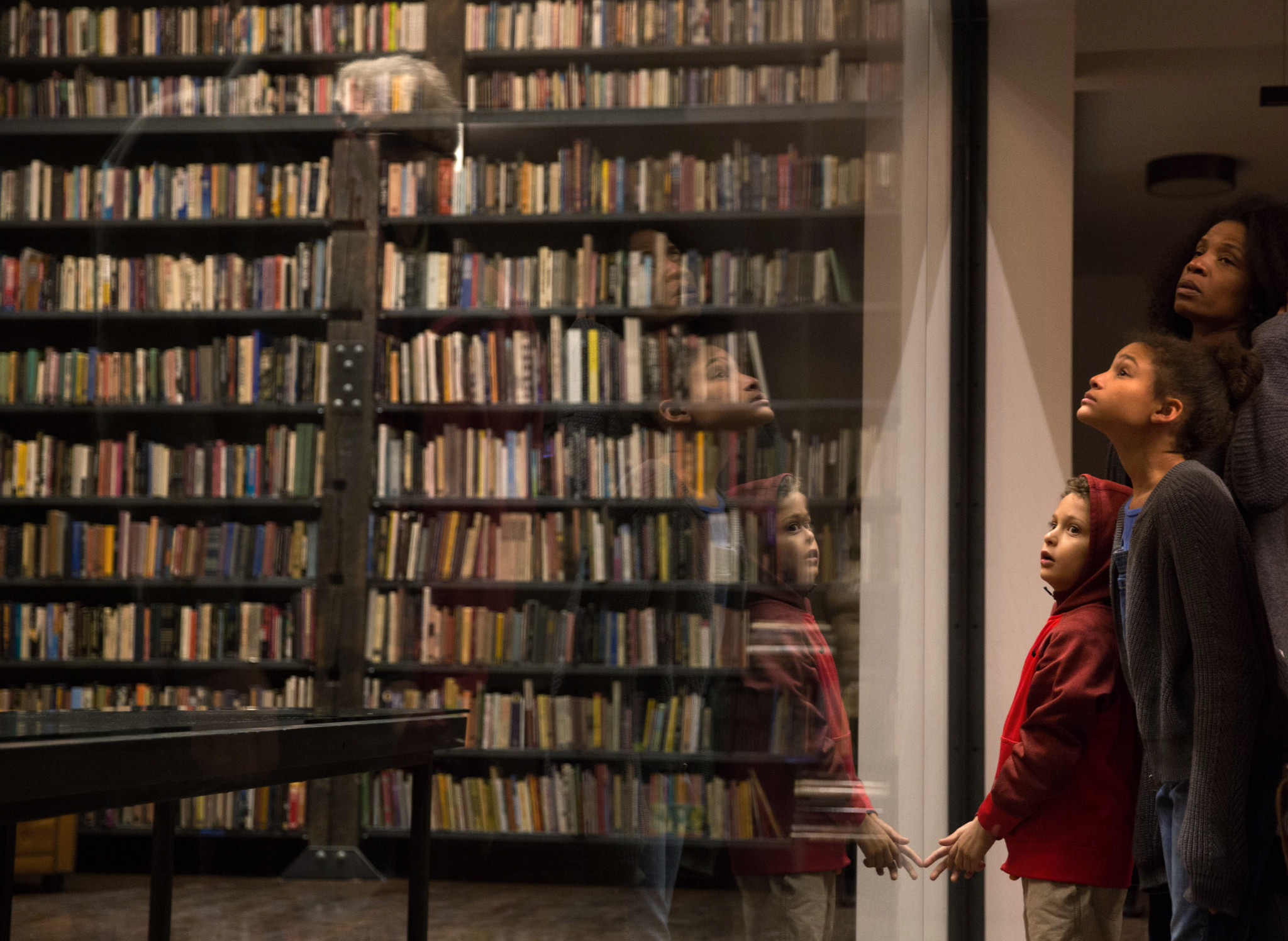Gates bought the building in 2012, when the city was selling dilapidated properties for one dollar. He cut old chunks of marble out of the bank’s interior, stamped “In ART We Trust” on them, and sold them in Switzerland for five thousand dollars each. He got the city to invest, got Art People to invest, got the place on the National Register of Historic Places, and opened on the first night of the Chicago Architectural Biennial.
It’s such a great story that a) it’s been told a million times and b) most reactions to the bank qua Arts Bank are either excited or neutral, a mix that does not really a discourse make. I talked to people at the opening, and the general pattern was this: if you had a ticket you were inspired, and if you had a uniform on you were confused.
Ticket: “I love that he’s preserving this music for the younger generations to come and listen to it.” Uniform: “It’s unique. Different. Good for the neighborhood, I guess.” Ticket: “They’re taking depleted buildings in the community and returning them to the jewels they are.” Uniform: “All I know is that it used to be an abandoned building and now it’s not.” Ticket: “This space is multifunctional—it’s just a space waiting to activate.” Uniform: “I don’t know what […] this place is for.”
I read parts of the application for the bank to be put on the National Register of Historic Places, looking for ways into thinking about the building’s rebirth. There are some good descriptions of the façade; here’s my favorite: “The Stony Island Trust & Savings Bank Building has two street-facing elevations, both clad in terra cotta imitative of ashlar gray granite masonry and displaying Classical-inspired decorative elements typical of early twentieth century American ‘temple front’ commercial architecture.”
I thought about that phrase “temple front” for a bit.
“The banking hall retains its original plaster archways, terrazzo floors and large coffered barrel-vaulted ceiling.” That’s from 2013. There seems to have been an effort at renovation minimalism: much of the vaulted ceiling that had fallen at some point since the eighties has not been restored, just smoothed through with plaster and white paint. The columns in the main hall are unfinished and rather “depleted.” The only places in the building that look cut and dried are the north and south walls, which are bare and gallery white.
The cardboard installation, by the Portuguese artist Carlos Bunga, shares the aesthetic. On the inside the structures are just cardboard; on the outside the walls are painted in reflection of their water-damaged housing, distressed where the packing tape joins the vertical sheets. A smaller version was installed in Cardiff, Wales, earlier this year. The use of the cardboard, Bunga has said, refers to “the act or action of beginning, the start of a forced journey to escape a hostile environment to get to another place.” The piece is thus called “Exodus.”
Bunga makes “process-oriented works,” as his gallery bio tells you, so at some point—there’s a video—he cut the cardboard pillars in Cardiff at their very roots and knocked the whole thing over, to the cheers of onlookers. His work, the bio continues, is made richer by “the interrelationship between doing and undoing, between unmaking and remaking.”
At the Arts Bank on Saturday night I saw Bunga’s work reflecting many things around it. In a very visual way it reflected the space back at itself: the somehow Classical cardboard structure giving the impression that it, too, had been sitting neglected since the eighties. And, as “Exodus,” it embodied Gates’ dream of revitalizing and—the most important thing the Israelites did—rebranding, leaving one identity and seizing another through a fast infusion of art.
I think Gates sees a kindred spirit in Bunga. Both artists like to play; they tend to pull pranks in plain view. Gates sold iPad-sized, $5,000 marble tablets from the London-based gallery White Cube; Bunga literally cut the Cardiff structure down to size and reinstalled the bases in perfect alignment somewhere else, labeled “Ruins.”
Is Bunga going to do the same with the iteration of “Exodus” that is currently at the Arts Bank? If he did, what, metaphorically speaking, would he be cutting down? At best, the overbearing architectural shadow of the South Side’s era of neglect—the dead weight of empty lots. At worst, he’d be challenging the hubris of trying to fix anything that is broken, or, perhaps, our presumption that material problems can ever have material solutions.
I’m guessing that Gates wouldn’t endorse an artist that could be seen as doing the latter—though his relationship with “establishments” is complex, he’s got one of his own now. There must be some kind of responsibility there, like that of the revolutionary the day after the revolution. He used to cleave at the Art World’s idea of itself. Will he—can he—continue to do so?
The building Gates bought for a dollar is in the “temple front” style; the Arts Bank it has become is, in a sense, “temple first.” It’s a beacon, and yet even the brightest light is weightless. Sometimes it seems like that is the idealist’s dilemma: someone has to try to construct the dream in real life, and it always looks funny at first. When I look at the Arts Bank, alone and upright, I see the two sides to that coin: both, “Don’t put the cart before the horse,” and, “Build it, and they will come.”
Clearly, I have my doubts. But I still saw what I saw on Saturday night: a nine-year-old boy tearing up Motown like Michael used to do; the guests greeting one another in every possible permutation; seeing a distinct look of hope, or answered prayers, or maybe just positive impression on nearly every face; young people staring wide-eyed at a vast library.

